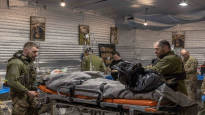Ukraine is currently having great difficulty defending itself against Russia’s growing military power. In recent days, the biggest battles have taken place on the outskirts of the town of Chasiv Jari, located about five kilometers west of Bahmut.
Chasiv Jar is a military tactically more important target than Bahmut or, for example, Avdijivka, which Ukraine lost at the beginning of the year. Chasiv Jar is located on a hill that dominates the lowland countryside. Before the war, the town had about 12,000 inhabitants.
If Russia succeeds in capturing Chasiv Yar, it will have the advantage of firing on the Ukrainians who are defending themselves below, and thus it will be easier to advance to the larger population centers in the nearby region, Kostjantynivka and Kramatorsk.
Military experts have predicted that Russia will launch a major offensive before the summer. The situation of the Ukrainian army is very difficult, because the material support of Western countries has dwindled and, for example, there is a severe shortage of artillery ammunition and anti-aircraft missiles. Russia would therefore be in a favorable situation to attack.
One of the main reasons why Russia started the war against Ukraine was to take over the Donetsk region. Kramatorsk and adjacent Slovjansk are the largest cities in Donetsk.
Kaihkö: Ukraine made bad mistakes
Doctor of military science Ilmari Käihkö points out that Chasiv Yar would be a good base area for the Russians if they get hold of it. But by the same token, it is now a good place for Ukrainian defenders. The Russians will have a difficult and demanding job of taking over the city.
Military historian who followed the war in Ukraine Emil Kastehelmi has published an X message thread in which he analyzes the situation of Chasiv Jari. Kastehelmi also mentions that Ukraine has built defensive fortifications in the city.
The picture published by Kastehelmi shows boarded-up trenches, which are quite shaky for fortifications.
Käihkö doesn’t know the fortresses of Chasiv Jar in detail, but according to him, Ukraine started the fortification work far too late, at the end of last year.
– This was a big misjudgment on Ukraine’s part, Käihkö states.
The background was the desire to show that Ukraine is progressing, even though there were no more resources for progress, says Käihkö. He regrets that fortification work was not done even on the critical front pillars.
– I have spoken with Ukrainian soldiers who were at the front. They already talked last summer that the Russians know how to fortify, the Ukrainians don’t. When the Russians occupy an area, they immediately start fortifying it. Ukrainians don’t start.
Now the question is whether Ukraine even has the resources to defend itself.
Käihkö wonders if Ukraine’s defense supplies are really as depleted as they say, but if it’s just talk to try to speed up the delivery of aid. If the situation is as bad as Ukraine says, a Russian breakthrough could be possible.
Ukraine is also not exactly prepared for a big Russian attack. For example, the business launch act was reformed only very recently.
Ukraine’s real fear
Käihkö wonders whether Russia intends to launch a major attack, no matter how favorable the situation is. This war has shown that attacking consumes vastly more resources than defending.
Käihkö thinks that Russia would need more manpower in any case so that a breakthrough battle could be fought. If some kind of mobilization was done now, the men would not be able to line up until months later.
The easiest solution for Russia could be to continue the current slow progress, Käihkö reflects. This means merciless artillery fire and aerial bombardment to destroy and then capture the cities of Ukraine left at the feet of the war. Flying bombs make population centers practically uninhabitable.
– In Russia, there has been talk of creating a “gray area”, i.e. a buffer zone. It could nominally belong to Ukraine, but Ukraine does nothing with it, and Ukrainians cannot live there.
The cities occupied by Russia have turned into ruins since the beginning of the war, but also in Kharkiv and Kherson, normal life is impossible because of the Russian fire, Käihkö says.
– This is the fear of Ukraine. And if Russia manages to advance closer to the big cities, they will have to evacuate the inhabitants.
What is essential is what Russia’s goal is, and especially the current goal, because goals change as realities change.
What is the big picture of war?
Käihkö thinks it’s most likely that the war will continue raging roughly as before. Russia is certainly considering a major attack.
A major attack can also be a bad solution from Russia’s point of view, as it might speed up aid deliveries from the West.
– We have a sense of urgency [Ukrainan tukijoilta] almost lost. A critical situation, i.e. a Russian attack, could make us realize that the war could turn very badly for Ukraine.
According to Käihkö, the big picture of the war is now that Ukraine has weakened and Russia has become stronger, but still cannot reach its goals.
Russia is unable to influence Ukraine’s international status or domestic politics.
– Russia may conquer Chasiv Yar, but it is not a question of the fate of the war. After Chasiv Yar, there will be new and new cities. The question is where Ukraine can create a defense line where Russia will be stopped, Käihkö sums up.
13.4 was discussed in the Everyday World Politics program. Ukraine’s ammunition situation.
Source: Reuters
